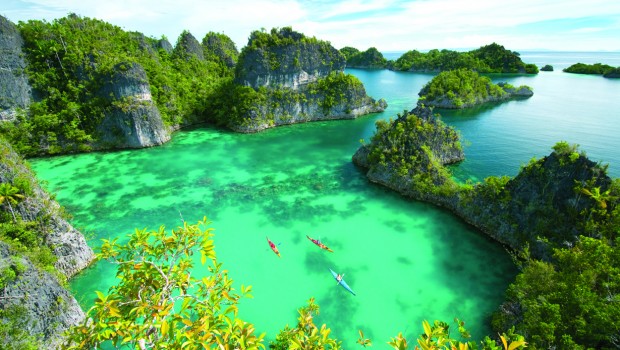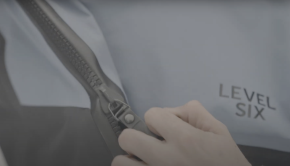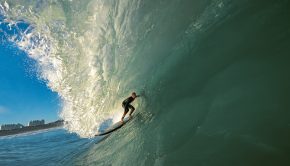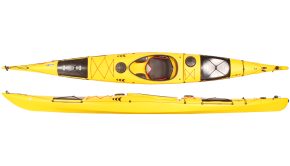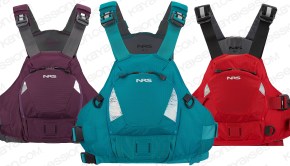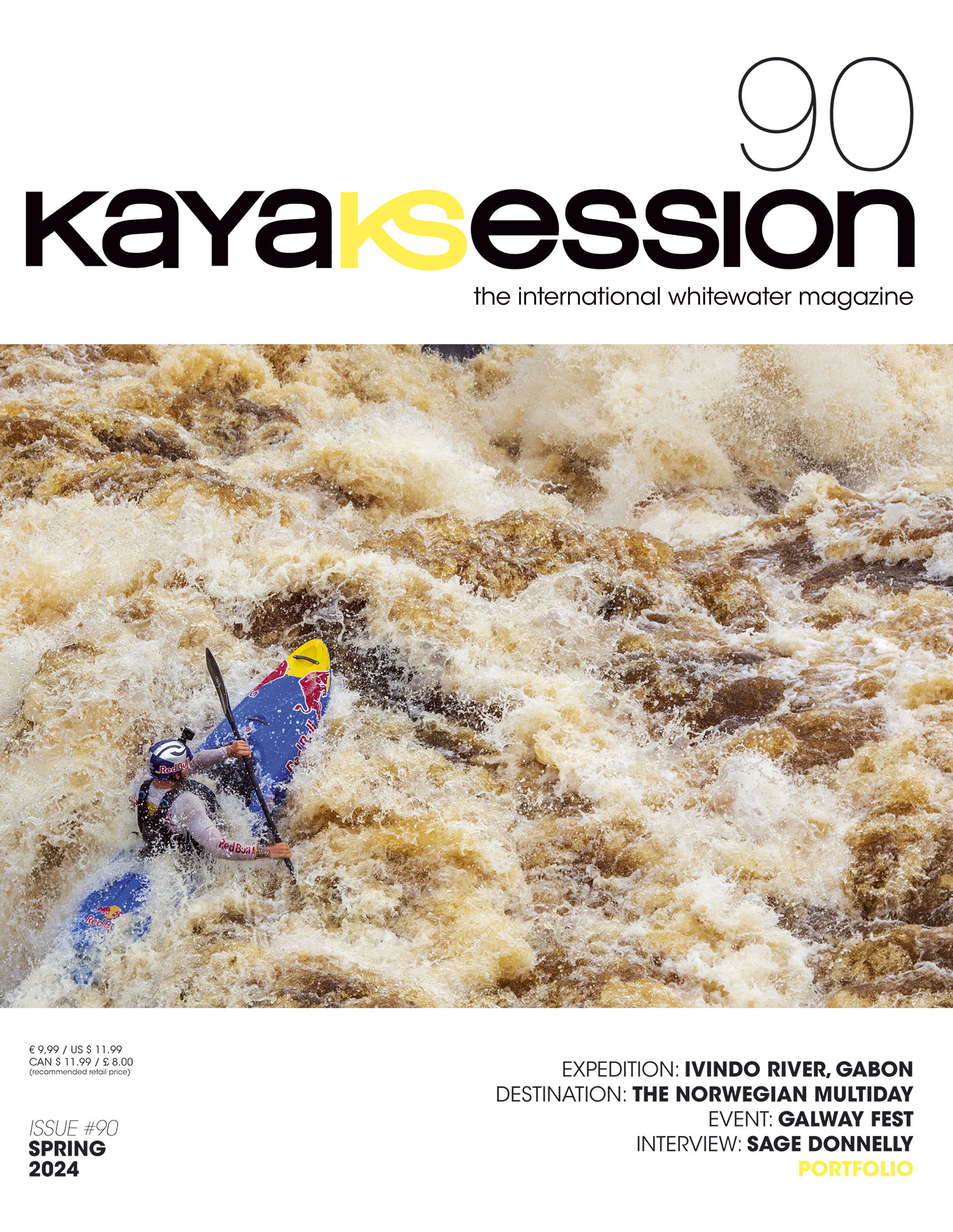Deep in the coral triangle between the Philippines, Indonesia, and Malaysia, lies the Raja Ampat Archipelago—a massive labyrinth of more than 1,500 islands surrounded by blossoming coral reefs and turquoise waters. Countless bays and inlets, hidden passages, dense mangroves, towering rock formations, and cascading karst caves make this a kayaker’s paradise. Jillian Macdonald and Frits Meyst formed the core of a small team of paddlers exploring this tropical marine wonderland. As they searched for giant mantas and the bird of paradise, they discovered tiny coastal villages and welcoming Papuan people along the way.
Through the Labyrinth of the Blue Water Mangroves
We’re lost! I no longer have any idea which direction to paddle, and neither do my fellow paddlers, though Frits, self-appointed navigator, will claim otherwise. He’s convinced we are on the right track. I’m convinced he’s lost. But I’m not sweating it yet, except for the drips and drops continually falling down my back and from my forehead, off the tip of my nose onto our only map, a dated depiction of Dutch New Guinea from 1957 that sheds little light on our position. Perhaps the fact that we are 50 kilometers from the equator in a mangrove labyrinth of roots and branches should make me concerned. But I am not worried—not yet.
The air reaches 40 degrees Celsius. The sun sears our shoulders. If we do find the lake that will lead us out of the labyrinth, our map shows no exit point, though a reliable source tells us of a passage. We have no GPS coordinates. We are amongst the first kayakers in the archipelago, and we must find our own way. It becomes impossible to turn the kayaks around. After an hour of paddling, the mangroves give way. “This must be the lake!” With a forgiving nod I respond, “Frits, that is Keorpiar Island, and across, the sea where we set out at sunrise. Your four turns left brought us back to our start point. Shall we begin again before the tide changes?”
We had left Kri Island in the dark of pre-dawn to cross the open sea early and beat notoriously shifting tidal currents and eddies. Reaching the shores of Gam Island and entering the maze of the Blue Water Mangroves, we had realized the vastness of our surroundings. Along our route we discovered a much larger maze of islands, reefs, and rocks in an archipelago that few have penetrated. This is Raja Ampat, The Four Kings of Indonesia.
A World Away
The ‘Hidden World’ of Raja Ampat is virtually untouched, definitely isolated and outrageously beautiful. This unique archipelago is made up of four major islands: Waigeo, Misool, Salawati and Batanta, plus hundreds of small uninhabited islands encompassing more than 9.8 million acres of land and sea off the northwestern tip of Indonesia’s province of West Papua, formerly known as Irian Jaya. Located in the Coral Triangle, Raja Ampat is the beating heart of coral diversity; 76% of all known coral species form the living room for at least 1,397 species of reef fish.
Usually a mangrove forest is deep in mud but here the water is clear and clean like an alpine mountain stream, only salty and deliciously warm. Thousands of tiny glass fish hang still between the tree roots. Colorful soft coral also finds a stronghold, swaying back and forth with the tidal current. After two hours of paddling, our determination is richly rewarded. A white sandy beach awaits. Two black tip reef sharks patrol the shallows, gliding by my feet as I unload the kayak. Our supplies are limited; compact camping gear and enough food and water for two days maximum. Yenbeser Village is nearby, and tomorrow we will try to stock up on fresh fish, rice and drinking water while practicing our various creative means of communication. In a few days we hope to meet with a back-up boat and fresh supplies. Until then we are on our own. Vincent makes a fire, and Frits puts his numerical fishing philosophy into action. “With 1,397 chances, one of these species has to bite.” Lazing in my hammock, a gentle sea breeze brushes my face. The sky has opened itself to starlit fantasies. I gaze upward, reflecting upon this land of unparalleled splendor.
In the Eyes of the Beholder
On land, miracles unfold. Lush forest, limestone outcroppings, rare plants, birds of paradise, and nesting beaches for thousands of sea turtles-they all come together to create a paradise on earth. For a handful of years now, Raja Ampat has been a diver’s dream with its oceanic currents sweeping coral larvae across the seabed, creating the perfect feeding ground for thousands of underwater creatures. We are literally amazed, though selfishly relieved, that sea kayakers have not flocked to Raja Ampat to be challenged by the sheer enormity of what is a relatively unpaddled world, aside from the local fishermen and their families, whose generations go back thousands of years.
The average Papuan moves about in a dugout canoe so a modern kayak is for them what an alien spaceship is for us. We are barely in sight of the village before dozens of wide-eyed children leap from the jetty into the water, ferociously flapping about to see who can reach us first. With such enthusiastic young limbs hanging on all sides, we barely manage to stay upright before we have no choice except to relinquish our paddles. The pure joy in the eyes of the curly headed children is enough to make us feel secure and safe as our supplies and very transport is paddled away. With various tasks assigned, we split up: one to keep watch on the kayaks, another in search of fresh fish and myself to find a shop for basic supplies.
From Harleys and Jeeps to Nature Lover – Our Reliable Source of Information
Setting out on this adventure has been a combined effort. First there is Frits, photographer, husband, cohort in all my adventures and the one behind the camera. Vincent, a strong and willing sporty young Dutchman has never ventured into the wilds, but was anxious to get away from his student project, and signed on. Then there is ex-pat Dutchman Max Ammer, our reliable source for beta. When Max first arrived in Papua over twenty years ago, he was set on searching for World War II wrecks left from the Battle of the Coral Sea. Little did he know that he would fall in love with the land, the nature, and most of all, the people.
Max had a profitable business back home restoring Harley motorbikes but, with a keen interest in the history of the war fuelled by generations of family memories from their time in Indonesia, he gave it all up, took an instructor’s course in diving, and headed to another world. Max’s interaction with the local people brought changes for him. “You can’t really live in a world without doing something for others. I saw that the Papuans needed help. The level of education was very poor. The people were being exploited and the sea was being robbed through over-fishing, especially dynamite and cyanide fishing. For the people, this was their livelihood. They knew nothing else. I wanted to help them find alternatives, to treasure their environment rather than destroy it. One day I saw a young boy selling turtles from his dugout. I bought them and immediately released them back into the sea. Then he was shocked, but today he understands.”
With his own hands and the hands of his Papuan friends Max built a home on Kri Island, and a land-based dive resort in Raja Ampat. Max employs only Papuans, and has helped develop educational programs with the support of various international organizations. He has been instrumental in stopping dynamite and cyanide fishing in the region, and helped the locals explore better ways to sustain themselves. He is welcomed as a special friend in every village he visits.
Naturally keen for travelers to explore Raja Ampat, Max explains, “What better way than in a kayak to get close to nature, into places where boats cannot maneuver? Most importantly it’s environmentally friendly. You can easily get to remote villages, hidden caves and inlets. Through the RARCC (Rajah Ampat Research and Conservation Centre) the Papuans are building homestays within their villages or near their fishing camps. It is an ideal way for kayakers to experience Papuan life and culture and for the locals to generate income.”
Seeing images of the landscape and talking with Max, Frits and I had been immediately hooked, and we were excited to finally be on the water exploring.
Dried Fish and Deet
Finding what looks like a shop is one thing, trying to communicate with the owner is a totally different affair. He is fixed on selling me dried fish, but their petrified eyes do not match even my hungry stomach. I settle for what looks like oatmeal, some rice, what I hope is cooking oil, and some wilting greenery that resembles spinach. My faith rests in Frits who is in search of today’s lucky fisherman. It will be rice and fish, rice and fish, and on the days when the fish are not jumping, rice. I am thankful for the small sachets of spices I brought from the market in Sorong.
While I have been miming my way through our shopping list, Vincent has managed to attract the entire village. He has been challenged to a race; kayak versus dugout. Vincent pulls power and sprints forward by a nose length until his Papuan opponent begins to paddle in earnest, leaving Vincent in his wake.
We make our way a short distance from the village of Wawiyai before we are forced to take shelter from the daily storm. Where rainwater filters through the soft limestone, hollows are created and we are awestruck as we paddle into one of them. It is an enormous bat cave with impressive stalactite formations. When the kayaks are secure we scramble onto the rocks to reach the inner passage of the cave, slippery slimy from bat droppings. From the cave we cross through the ‘‘Straight of Death:’’ human skulls and bones line the rockcrevasses and fill small caves. Papuan tradition is to bury their dead above ground in rocks where the remains are accompanied by old family heirlooms.
Once the storm clears we move on, and the closer we get to camp the more interesting the landscape becomes. All around us steep rocks with cascades of wild orchids rise from the sea. Ahead I notice what appears to be a tunnel. With barely enough space for my head I paddle into what surely must be the Garden of Eden, an oasis between the rocks. It is simply miraculous, but we must leave before the tide closes our only exit. Another impending storm requires hard paddling against the waves to reach a fishermen’s camp where we will base for three days. Our campsite is short on beach, but it is big on welcome. Fresh supplies have been dropped; sachets of ginger tea, coffee, dried milk, oatmeal, cinnamon cake, cookies, fresh veggies, and most importantly 30 liters of fresh water. Much to our surprise a huge tarp for shelter has been set up amongst the trees, and a floor of palms spread out next to an open fire. Apparently one of the kitchen cooks back on Kri was not making much of an impression on those who sampled his food, so Max has sent not only supplies, but our very own camp chef! While we gobble up stir fried veggies and yes, more rice, the sun sinks like an orange comet behind the horizon.
We are between nothing and nowhere, yet, in the middle of the night, the noise is overpowering. Children and dogs are fighting in a howling match and, as far as I am concerned, the rooster is ready for the pot! It’s the middle of the night yet it’s time to go fishing and all the locals in the camp are busy preparing. In the morning it is clear that Chef has also been busy. He has placed a plank of wood from bow to stern in a still unfinished dugout canoe. It doesn’t quite reach either side, revealing a puddle of malaria-ridden mosquito larvae just begging to hatch! Ours is quite the breakfast table! We count our blessings for the ample supply of deet repellent and anti-malaria tablets we stocked up with before leaving Europe.
Bathing in Commando Gorge
Leaving our camp for a day trip, we skim across the sea in kayaks unburdened of weight. We are in search of a river and a waterfall Max has told us about, but most of all, fresh water to shed the sand, grit and salty sweat. Back at camp, chef is likely preparing yet another pot of rice today, which will become nasi goreng (the traditional Indonesian dish of fried rice) tomorrow. For us, it’s bath time. We travel up river into primary rain forest. Hornbills, lorikeets and parrots swoop overhead, coaxing us to venture farther with their inviting chatter. Eventually enormous boulders block our passage. If we truly want to reach Max’s waterfall we will have to go it on foot. Beastly horse flies are starting to drive Vincent mad, and he declares war on each and every one of them. With packs overhead in waist deep water we slip and stumble. It is impossible for us to know if our efforts have brought us to the waterfall Max has described, but we don’t care. This is it. It’s bath time.
Rumbling skies and increasing winds tear us away from our fresh water escape, and we race back to camp. For the next three days chef attempts to dazzle us with his methods of cooking rice. The children, dogs, and locals continue their nightly shenanigans. We will never get enough, nor see all of the Garden of Eden, which has become my sanctuary for thought and reflection.
Our journey is far from over but we relish our moments atop a spectacular world that dances in the sunlight, a watery looking glass that reflects life in its gardens above and below the surface. The sight of so many shimmering islands, seemingly floating on top of this world, renders us speechless. While the landscape may appear as a dream, this is not an illusion. It is Raja Ampat.
(article published in paddle world mag 2011).

